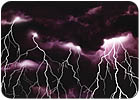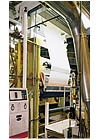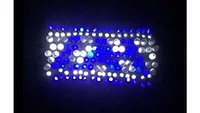Protecting Adhesive Tape Systems From Static Electricity

Pressure-sensitive adhesive (PSA) tapes are prone to the buildup of electrostatic charges. If you have ever felt the hair on your arms stand up when near an unwinding roll of tape, you have felt static electricity.
High levels of electrostatic charges can be dangerous, and moderate levels can permanently destroy the adhesive system, fouling and jamming production processes and damaging finished products.
New technology, which allows faster production speeds, exacerbates static-related problems in the adhesives tape system. To reduce static, operators sometimes will intentionally slow down the production process, which can be a costly solution.
For these reasons, users and converters of pressure-sensitive tapes need to understand static electricity: the causes, the hazards, and the most effective ways to control it.

The Cause: Contact and Separation
Static electricity is an accumulation of electrical charges on a surface. The polarity of the charge can be the result of an excess of electrons (negative charge) or a deficiency of electrons (positive charge). Charges accumulate on the surface of non-conductive material, such as paper or plastic film; they can also accumulate on ungrounded conductors, such as machine parts and the human body.When surfaces are in contact with each other, a transfer of surface electrons occurs. Friction, pressure and web speed will accelerate this transfer. When separated, the surface, which has gained electrons, becomes negatively charged, and the mating surface giving up the electrons becomes positively charged.
This process, known as triboelectrification or tribocharging, results in the generation of static charges on the surface of PSA tape as it unwinds from the roll and contacts and separates from surfaces such as idler rolls, nip rolls, and printing or coating rolls. The buildup of electrostatic charges is a cumulative process, increasing each time the web contacts another surface. PSA tape can therefore accumulate a high charge as it passes through transport systems where it comes in contact with several idlers.
On non-conductive materials, such as the papers and films used for PSA tape, charges do not build up uniformly across the surface. A single contiguous surface may accumulate a positive charge in some regions and a negative charge, or no charge, in other regions. The intensity of charge will also vary dramatically.
The Impact
The shock or spark caused by so-called electrostatic discharge (ESD) events is common. On a small scale, you feel an ESD in the form of a spark when you touch a door knob after walking across a carpet. On a much larger scale, an ESD is observed when lightning storms light up the sky. An ESD occurs when a static electrical field exceeds a certain threshold value, causing an ionized conductive channel to form in the air as nature's desire for balance plays out.Personal Safety. In the production environment, an ESD event may simply result in an uncomfortable electric shock or, if charges are high, the shock can cause burns or even cardiac problems. In addition to the direct health effects of exposure to electrical current, there is also the secondary hazard of operators suddenly recoiling from the shock and injuring themselves by falling against dangerous machinery.
Explosion and Equipment Damage. Static discharge often results in a spark. Areas with flammable liquids or gases, such as solvents, must remain spark-free at all times. Electrostatic discharge can have sufficient energy to ignite hazardous vapors in coating heads and gravure printing operations. An ESD event can also disrupt logic in PLCs and sensing equipment, causing processing errors and costly down time.
Damage to the Adhesive System. Static buildup and ESD events can damage the PSA release liner of the product being unwound. When the silicone coating is disrupted by static, it will no longer function as a release system in the area affected by the discharge. The adhesive will "split" between two sides of release liner. Alternatively, the liner can fail to release where it is damaged, making it very difficult to remove the liner as designed.
Equipment Jams and Product Damage. The accumulation of electrostatic charges can cause problems, even if ESD events do not occur. If static charges are not neutralized, sheets of materials will stick together, creating jams in downstream processes. Electrostatic fields also attract dust particles, fibers, bugs and hair, resulting in surface contamination. This causes obvious quality problems in printing, coating and laminating, and cleanliness problems with medical PSA applications. Moreover, static charges can cause uneven coatings and "wicking" of inks, and pressure-sensitive tape carrying a static charge can damage sensitive electronic components.
Controlling Static
A number of measures can be taken to control the effects of static electricity during the use and conversion of pressure-sensitive tape.The first step is to identify the "hot" areas that appear to generate the highest static charge. This can be accomplished with a small, inexpensive handheld electrostatic field meter. You will reach your own comfort level but, in general, action should be taken wherever the charge approaches the 5-kilovolt range.
Material selection in the composition of the PSA system has a significant effect on the propensity for the generation of static electricity. One reason that release liner materials such as plastic film and poly-coated paper are selected is because of their low hygroscopic quality (low moisture absorption), which provides resilience to the damaging cockling (wrinkling) effects of exposure to humidity. Paradoxically, this resilience to humidity makes these materials more prone to the accumulation of static charges on the surface. In contrast, hygroscopic material, such as densified Kraft paper without poly-coating, benefits from the presence of water molecules that facilitate the movement of electrons, which helps reduce electrostatic charges on the paper's surface.
The relative humidity of the ambient air has a similar effect. The moisture in humid air helps to dissipate electrostatic charges and reduce charge buildup by increasing surface conductivity. High relative humidity will reduce charge formation, but will not prevent static charge buildup and discharge. Maintaining relative humidity above 50% will lessen the likelihood of static problems on hygroscopic materials such as uncoated paper. This can be accomplished with a humidification system such as a simple series of water misters.
The design and maintenance of equipment is also important in controlling static. Because friction and pressure can accelerate the buildup of static charges, it is important to minimize slippage in the transport system. If the PSA tape contacts an idler roll that is not turning freely, or if it travels over a stationary bar or machine surface, the material can become highly charged. Conductive materials, such as metal rollers, need to be continuously grounded. Rollers and the shaft of the PSA roll itself can become electrically isolated because of non-conductive lubricants, dirt and rust, and excessive clearances of the bearings, especially during high-speed operations. To detect such problems, resistance-to-ground measurements should be performed while the machinery is running at normal operating speed to ensure proper ground at all times. This is extremely critical in solvent coating and gravure printing processes.
Static Control Devices
Three types of static control devices are commonly used in production facilities where pressure-sensitive adhesive tapes are used and converted: grounded pads, passive ionizers, and active ionizers.Grounded pads, also called antistatic protected floor mats, provide operators with limited protection from ESDs due to induction charging of the human body. If the operator is standing on a properly grounded pad (connected to ground with a proper current-limiting resistor) and with conductive footwear (not rubber soles), the pad can reduce operator shocks. But grounded pads do not eliminate the other problems caused by static electricity and do not protect the operator from direct discharge from a highly charged unwind or rewind roll, for example.
Ionizers offer a more effective approach. Ionizers produce large quantities of both positive and negative air ions. These ions are directed to areas where electrostatically charged surfaces require neutralization. The ions of opposite polarity are attracted to the charged surface until electrical equilibrium is achieved.
There are two general types of ionizers: passive ionizers and active ionizers. Passive ionizers, also called induction ionizers, include static tinsel and static string, which are simply grounded emitters placed parallel with-and close to-the charged material. The electrical energy of the charged material will excite the passive ionizer, causing it to generate air ions of the opposite polarity. If properly positioned, a passive ionizer can successfully reduce bulk electrostatic charges. Typically, an active ionizer may follow the induction ionizer to "clean up" residual charges, especially in critical applications.
Passive ionizers have the advantage of low purchase costs. However, a passive ionizer is highly operator-dependent. It must be positioned at the correct distance from the web, and not come in contact with it. If a passive ionizer comes in contact with the charged material, it may become ineffective and the filaments will wear off and contaminate the web and the machinery. If positioned too close, it can overcompensate and result in a charge of the opposite polarity. It must be replaced whenever it becomes dirty or damaged.
Active ionizers have a higher purchase cost, but are much more reliable and require minimal maintenance. Unlike passive ionizers, they are electrically operated or use radioactive materials for the ion source, and are not dependent on local conditions or the electrostatic charge on the web.
High-output static neutralizer bars are the most common type of active ionizers for PSA applications. They are highly efficient, electrically powered bars that are permanently mounted across the web. Another type of active ionizer is a static blower, which uses fans to blow positively and negatively ionized air at the moving web, thus neutralizing the charged surfaces.
According to Scott Shelton, North American Sales manager at Simco Industrial Static Control, there have been several important recent advances in static control technology. For example, the new patented Simco Roll Follower uses photo sensors to detect the outside diameter of unwind and rewind rolls to continually reposition the static bar to maintain the optimal distance from the material roll. State-of-the-art static bars perform effectively at distances of up to 20 inches from an unwind or rewind roll, or up to 6 inches from the web, even when the web is traveling at high speeds. The newest bars are also self-monitoring, with fault monitors and alerts to indicate when they require cleaning.
Safe, Efficient Production
There is no need to slow down your production process to avoid problems with static electricity, even during the dry winter months. A trained static control engineer can evaluate your facility and determine the best option for controlling static on your equipment for the benefit of your employees, your products, and your customers.For more information, contact Adchem, 1852 Old Country Road, Riverhead, NY 11901; phone (631) 727-6000; fax (631) 727-6010; e-mail info@adchem.com ; or visit http://www.adchem.com .
Links
Looking for a reprint of this article?
From high-res PDFs to custom plaques, order your copy today!




